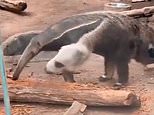
‘This tripped me out!’ Bizarre video that appears to show an anteater with two HEADS baffles the internet – so can YOU see what’s really going on?A bizarre video appears to show an anteater with two heads The animal is eating, but it appears to have another furry, white head assisting itConfused viewers took to Twitter to discuss it, with one saying it ‘tripped me out’
A bizarre video that appears to show an anteater with two heads has left the internet baffled.
The clip, shared on Twitter this week, shows the animal eating from a log, but it appears to have a second furry, white head assisting it.
The anteater moves its snout along the bark, with the other ‘head’ following it in unison.
Confused viewers took to Twitter to discuss the unusual footage, with one remarking it ‘tripped me out.’
The video makes it look as though the Giant Anteater has two heads – when in reality it’s just one of its legs
The viral video was posted to Twitter by user @buitengebieden with the caption ‘Took me a minute…’, and has garnered more than 26 million views.
The clip was originally filmed at Franklin Park Zoo in Boston, Massachusetts.
One viewer replied: ‘I thought the dude had two heads, took me five minutes to make sure I wasn’t tripping’, while another said ‘this tripped me out’.
One added: ‘I still don’t get what’s happening. A two headed creature – one’s an anteater, one is a goat. Three legs and a peacock tail? Why is he wearing shoes?’
The second ‘head’ is actually the anteater’s camouflaged forearm.
Unlike the grey-brown body of the mammal, the legs remain white and fluffy, with bands of black around them.
It has the effect of making the paws look as though they have a nose and eyes.
The clever adaptation, however, is not just there to scare off predators, but it also acts as a form of camouflage.
Giant anteaters are largely solitary animals, with females only giving birth to one offspring a year.
Once they are considered fully grown, usually around two years old, they leave their mothers.
Before this happens, however, the female anteater carries its young on its back.
The video of the anteater was filmed at Franklin Park Zoo in Boston, Massachusetts. The anteater uses its left leg to help it eat
The stripe on the baby’s back always lines up with the mother’s lines, which means the young animal is virtually made invisible, protecting it from predators.
The fur also covers up the species’ giant claws, used to crack open anthills, as the animal has no teeth.
Those who noticed the interesting adaptation were amazed.
One tweeted: ‘Woah – how’s that for evolutionary genetics. Amazing.’
Another said: ‘Ohhh, he’s got a white foot. Optical illusion. Took me ages to work it out.’
Some even pointed out that the leg looks like a crooked panda face, with the black circles on the white paw looking similar to the bear’s eyes and nose.
The Giant Anteater: the world’s biggest anteater species
Giant Anteaters are the largest of the anteater species and are found across most of South America and parts of Central America.
The animal can reach up to eight feet long from the tip of its nose to the end of its tail.
It is covered in gray, brown fur with white front legs with black stripes running from its chest back to its bushy tale.
The number of anteaters has diminished over the years, as a result of deforestation and loss of grassland habitats.
To eat ants they use their sharp claws to knock down the opening on anthill.
They then stick their long snout into the anthill, using their sticky saliva and long tongues to get the insects.
Interestingly they try not to completely destroy the mound in hope that another ant colony will return.
According to the International Union for Conservation of Nature (IUCN) Red List, giant anteaters are the most threatened mammals in Central America.
They are already considered an extinct species in Uruguay, El Salvador and Guatemala.
Giant Anteaters are the largest of the anteater species and are found across most of South America and parts of Central America
Advertisement
Share or comment on this article:
Source link
CHECK OUT: Top Travel Destinations
READ MORE: Travel News



